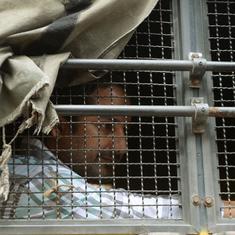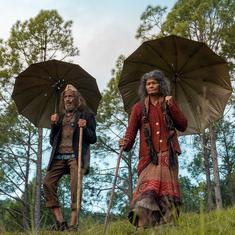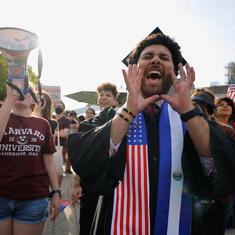Nimsara and Themira remember the first time they entered a sports stadium. It was a hot day in March 2016. They had woken up early and were headed for their destination, flushed with anticipation: they were going to a cricket match, after all, and in Sri Lanka, there is always something to look forward to in a cricket match.
For Nimsara and Themira, and the hundreds of schoolboys beside them, though, the match meant something more. It was the first day of one of the world’s oldest-running cricket matches: the Battle of the Blues, also known as the Royal Thomian, the 145-year-old annual cricket encounter between two of the oldest schools in Sri Lanka – Royal College, located in the country’s capital Colombo, and S Thomas’ College, located in the suburb of Mount Lavinia.
As Nimsara and Themira entered the stadium, the Singhalese Sports Club, they felt overwhelmed. Until now, they had always imagined the match to be just that – a match.
Yet looking around, seeing numerous “distinguished” Old Boys from their school, including political leaders and corporate heads, engaging in casual conversation with each other, they understood that this was much more than a match. It was a gathering of Sri Lanka’s elite and has historically served as a backdrop of the nation’s elite politics.
However, Nimsara and Themira caught only a glimpse of these people. Almost soon after entering the field, they retreated to a tent elsewhere, a tent reserved for students.
While the players got ready in the pavilion, the spectators began streaming in, making their way to this tent or that, setting themselves in one camp or another. Nimsara and Themira were in the Boys’ Tent allocated to students from their school and overseen by a batch of Stewards from the 12th Grade. The ticket cost 50 Sri Lankan rupees (about 23 Indian rupees). It included lunch and ice-cream.

At around 10, the teams entered the field. The stadium broke into a blaze of sound and fury. In the middle of the field, principals and school officials watched as the umpire tossed a coin. As the players ran to their sides, a band began to belt out a song and the match commenced.
From the Boys’ Tent, Nimsara and Themira watched it all unfold. The Stewards, fulfilling what seemed to be their role, shouted at the boys to cheer their team. This was their first test of confidence: they had never raised a cheer before. As they dutifully hollered at each passing ball, they felt their nervousness drain away.
The music was another thing altogether. The band belched out one tune after another and the boys sang along, often adding lyrics of their own.
Some of these lyrics were afterthoughts, unmentionable obscenities they would not utter so loudly elsewhere. With the Stewards beckoning them on and their friends answering their call, though, Nimsara and Themira were encouraged. Something in them gave way, and they joined in, raising their voices as they progressed from one song to another.
At noon, the gates and barricades opened for lunch and schoolboys and old boys, friends and total strangers, flooded the field. Nimsara, Themira and their friends walked onto the pitch. All around they saw friends embracing and talking animatedly, sloshing down beer, ignoring the heat of the sun.
By 3 pm, the air was rife with the smell of arrack and an irresistible mixture of baila – Sri Lanka’s most popular musical genre – and riotous swearing.
Finally, at around 5, the match closed for the day.
The next two days unfolded in much the same way. By the third and final day, the crowds had grown, and Nimsara and Themira had become part of the melee that had intimidated them before.
The encounter ended in a draw. Once it was over, everyone invaded the field, dancing and singing along as though nothing mattered.
This was Nimsara’s and Themira’s first Royal Thomian. It would not be their last. As the years went by, the two of them immersed themselves in the customs, practices and traditions of the match: the little details that spiced things up.
What intrigued them most was how the match opened up even the most reticent among them. As one spectator put it, “Everyone turns into a different being here.”
It was a cricket match, yes. But the cricket did not seem to matter.

A historical outline
The Royal Thomian is more popular than the many Test and one-day international matches that dot the island-nation’s sports calendar. It unfolds every March, customarily on a Thursday, Friday and Saturday.
Every year, Old Boys take the first chance they get to return home, like a pilgrimage, through whatever way they can, to meet long lost friends, share a beer, sing, dance and cheer. Though the cricket occupies a secondary place there, the match itself occupies an important place in the history of the sport in Sri Lanka – and in South Asia.
Like tea plantations, public schools, and the civil service, cricket came to Sri Lanka with the European colonisers, specifically the British. Like all things British, it was introduced by the colonisers to help insulate themselves from the locals.
In India, the first cricket clubs were formed in 1792. Four years later, the British annexed Sri Lanka, then known as Ceylon, from the Dutch.

Despite a promising start, cricket took time to get fully established in Ceylon. The island’s first cricket club was formed only in 1832. Like in India, it was first restricted to a narrow circle of colonial officials, the military and plantation owners.
This was a crucial period in the island’s history. In 1832, the British government appointed a Commission of Inquiry to assess the state of the country’s administration.
The Commission made several recommendations. Among these was the establishment of a public school to impart an English language education to the sons of elites and prepare them for the civil service. In 1835, that school, the Colombo Academy, opened in the island’s capital. Forty-six years later, it obtained a Royal decree and was renamed Royal College.
Staffed by Anglican missionaries and British headmasters, these schools promoted European culture and Western values. Sport, particularly cricket, became a marker of social status at such institutions, distancing their students from the world outside. The models they adopted were invariably British, with Eton and Harrow as the preferred prototypes. Their clientele were the sons of planters, administrators and chieftains.
In 1851, the Anglican Diocese of Colombo founded S Thomas’ College. Unlike the Colombo Academy, which was non-denominational, S Thomas’ sought to impart a more religious education. In 1864, it held what is now regarded as the first school match and the first “Ceylonese match” in the country, against the Small Pass Cricket Club, where S Thomas’ recorded an eight-run victory.
The Royal Thomian’s long saga commenced when the Colombo Academy appointed Ashley Walker, an old boy of Westminster College and a Cambridge Blue, to boot, as a mathematics tutor in 1877.
Walker, who is celebrated today as the father of Ceylonese cricket, was soon appointed as boarding master at the Academy. He went out of his way to promote cricket at school and to this end formed a rather formidable student team.

Having developed the sport in the Academy, Walker then wrote to the sub-warden of S Thomas’, outlining his plan for an inter-collegiate encounter.
The first recorded fixture of the “Academy versus College” match, as it was called at the time, took place in 1879, with Walker captaining the Academy. The Academy won the toss and elected to bat. At the day’s close, it emerged champions.
At the first match, the teams included both teachers and students. The changed the following year when students took the lead. The Academy prevailed there as well, with a lead of 62 runs.
From the beginning, the match took on the character of a social event, with the active if obligatory participation of the island’s upper classes.
For them, sport, in particular cricket, became more than just a game: it was a marker of social status.
As the years progressed, the schools and the match produced many of the country’s leading figures, including lawyers, doctors, planters, entrepreneurs – and the country’s politicians.
In 1928, the match was rechristened the Senanayake Shield. It was named for DS Senanayake, who had played for S Thomas’ more than two decades earlier, would become independent Ceylon’s first prime minister 20 years later.
The year 1979 marked the centenary of the match. At the end of the Royal Thomian that year, Sri Lankan President JR Jayewardene, who had played for Royal in 1925, granted permission for it to be changed from a two-day to its current three-day format. Since then, the match has continued without any major modifications.
This is, admittedly, an all too brief historical summary. Yet, it underlies at least three essential points about the Royal Thomian.
First, in the words of fervent old boys and diehard fans, it has “stopped for nothing”. Not even two World Wars – even if it has had its share of delays and postponements. That has given it a stamp of continuity enjoyed by few other cricket matches elsewhere.
Second, such historical legacies tend to provoke the most passionate emotions – as they did in 2020, when President Gotabaya Rajapaksa, facing a crisis during the Covid-19 pandemic, said at a meeting that he had asked the organisers to call off the match over health concerns.
Ironically, in 2021, it was to the president’s nephew Namal Rajapaksa, who was the sports minister then, that a group of concerned Old Boys presented a petition, urging the government to grant permission for the match to be held in order to maintain “the distinction the encounter has had for generations”.
Third, and perhaps most significantly, the match serves as a backdrop or a culmination to a series of other cricket rivalries – each with their own histories behind them – that unfold like a ritual every March, lending themselves to the moniker “March Madness”.
Today, cricket, like every other facet of life in Sri Lanka, has become more grounded in Sri Lankan society: a far cry from what it used to be under colonial rule. This has been no less true of the Royal Thomian – though it has managed to maintain its elite veneer.
Class, politics and baila
For all intents and purposes, the Royal Thomian is not just a cricket match. But to define it in terms of what it is not, is to ponder on what it is. That, however, depends on who you ask and what perspective you adopt. Perhaps the best way of defining it without essentialising it will be to examine the many contradictions that underlie it.
To outsiders, the Royal Thomian seems to be a gathering of a social elite, a class that sees itself as superior to everyone else. But to insiders, there are no such demarcations: all those who make themselves part of the proceedings eventually fall in line with the mood of the event. “There’s nothing classist about the match,” saud one Old Boy, beer can in hand. His friend cheerily agreed: “It doesn’t matter where you come from.”
Certainly, the Royal Thomian – with its cacophony of baila, drinking, and endless merriment – is a far cry from what it used to be in the early 20th century. Back then – lodged between the Victorian and Edwardian eras – the event resembled an Ascot race, with sharply tailored suits and top hats all around. That era has long gone.

To be sure, students take pride in its elite character and do everything to maintain its status. But that quality doesn’t really come out on the field or the many tents on both sides of the field.
This is because the elite have their preferred spaces at the match: prominently at the Mustangs Tent, the male-only club with a history of more than a hundred years that is open only to the highest echelons of Sri Lankan society. Here, traditional rivalries transform into perennial friendships.
It is not unusual to spot parliamentarians who make a career out of bickering with each other dancing, singing, even locking arms. Occasionally the members of these tents invite special guests:this year, it was the Indian High Commissioner and the US Ambassador.
Some of the invitees leave feeling dazed. Others feel amused. As one former ambassador recalled, “Part of my work involved visiting government ministers and Opposition lawmakers. They invariably badmouth one another. Seeing them hang out with each other so casually at the tent confused me. It almost felt like a drama.”

Old Boys, even students, will defend such contradictions on the grounds that the Royal Thomian is no place for politics: if you are part of the crowd – if you are an Old Boy – you bond with one another.
Yet, these paradoxes invite their fair share of criticism, with some accusing the event – and not altogether inaccurately – as whitewashing the excesses of the political elite, many of whom hail from either of the two schools.
It would be naive to claim that politics plays no part at the Royal Thomian. It does, often in not-so subtle or diplomatic ways. The 2015 encounter, for instance, unfolded three months after what was dubbed as a “Royalist coup”: the election of a government, most of whose ministers had been educated at Royal College.
Indeed, as one newspaper editor pointed out at the time, “the subtext [of the match was] that these people were back in charge now”.
Responding to the charge, one MP bluntly agreed and added, “We’re bringing with us the values we learned at these schools: inclusiveness and common decency.”
Historically, these schools were also the nurseries for the country’s elite politicians. For much of its post-independence period, the political leadership in Sri Lanka – Ceylon until it became a Republic in 1972 – shifted between two main parties, the United National Party and the Sri Lanka Freedom Party. Most of the country’s leaders hailed from leading schools, including Royal and S Thomas’.
The situation has changed today: there is more room for those from outside elite circles to enter the corridors of power. But these institutions have also, in their own way, accommodated the social and political changes that have swept through the country since independence.
Still, the charge that events like the Royal Thomian are gathering spaces for the elite has managed to stick. When match season is around the corner, critics on social media begin to decry the match as a snooty affair.
The venue of the match has itself become an attraction. The inaugural encounter unfolded at Galle Face Green, the fashionable Colombo promenade. From there, it shifted to the Nomads Cricket Club, the Colombo Oval, the Nondescript Cricket Club and the Singhalese Sports Club. These were, and remain, the most lucrative sports clubs in the country: the Singhalese Sports Club, for instance, recently celebrated its 125th anniversary.
Yet, despite these charges of elitism, the Royal Thomian has readily absorbed several popular, non-elite cultural elements. These include the music.
In the early 20th century, one invariably heard only English songs – an Old Boy from Royal College who passed out in the early 1950s recalls that “Sinhala and Tamil were unheard of.” Today, by contrast, English songs have become something of an exception.
A typical Royal Thomian playlist would consist of Sinhala baila. Its characteristic beat puts wings on everyone’s feet: “It’s hard not to dance when you hear it,” one spectator put it. A thoroughly hybridised art form with a long and rich history, baila has now become an essential part of every function, from parties to weddings to corporate events. At the Royal Thomian, it occupies a pivotal place, following a rather predictable pattern.
To be sure, baila may not be to everyone’s liking. The uninitiated can find it too loud and too vulgar, too “masscult” or lowbrow for their tastes. But with time, it has transformed the Royal Thomian, along with its social composition.
One spectator put it heartily: “Who the hell listens to symphonies here?”
A rite of passage
Perhaps more than anything, the Royal Thomian provides an opportunity for old boys to relive and reclaim their childhoods. For students, it serves almost as a rite of passage: a grand spectacle against which they grow into adults while still retaining the joie de vivre of their schooldays.
To be a schoolboy, in this scheme of things, is to break every rule in the book. That can be rather disconcerting for first timers: at the Boys’ Tent, for instance, not even teachers can forbid students from spitting out the obscenities without which no Royal Thomian, or baila session for that matter, would be complete.

Pulindu, a student who appeared for his final exams this year, recalled his experience only too well. “At first I wondered why teachers were okay with us singing these songs,” he said. “It was like breaking a vow. The more I sang, the more I felt like a part of it all.”
At the Boys’ Tent in last year’s match, Pulindu played a different role, as a Steward: instead of singing these verses, he had to get others to sing.
“The highlight was when the principal entered the Tent,” he said. “Even he was taken up by us. He just joined in and started talking and joking with the boys.”
Age becomes just a number. Students defy adults, and adults, for their part, encourage their behaviour. It’s not unusual to see the youngest and the oldest of students and Old Boys sharing a beer and a smoke, complete strangers though they may be. No less unusual is the sight of fathers encouraging their sons to indulge in the most outlandish activities.
One not-so Old Thomian captures this well: “The Royal Thomian is primarily about boys – including those disguised as older and wiser men.” Perhaps this is why most Old Boys, even former prefects, wear shorts at the match.
The tents serve a similar function here. Apart from the Mustangs, the Royal Thomian hosts several other tents, each belonging to a particular batch and generation. “The idea,” a member of Stables – put up by S Thomas’ “Class of 1979” – argued, “is for students to move from one generation to the next, from childhood to adulthood.”
Unlike a rite of passage, however, the student does not “lose” his childhood as he progresses from one tent to another: he reclaims it and, in a manner of speaking, relives it. In other words, it becomes a rite of passage in reverse.

Of course, this is not to say that the Royal Thomian is anarchic, or that it disregards every rule in the book. There are strict demarcations of roles and responsibilities, particularly within the student body: Stewards oversee the students at the Boys’ Tent, while Prefects – the only people, outside the players, the security personnel, and the Organising Committee allowed into the stadium while the match is going on – patrol the area.
Donning sunglasses and straw hats, with a stern demeanour that occasionally dissolves into smiles and laughs, they represent an ideal to aspire to for the boys: at both schools, becoming a Prefect is the highest honour a student can receive.
The Royal Thomian is the first event of the year where Prefects officiate. As far as the match goes, they are the highest authority figures: teachers have little say here.
Teachers also have little say over the events that lead to the Royal Thomian. These include a cycle parade and an “unofficial” vehicle parade. Arguably the most notorious of them all is “trucking” – the practice of jumping into nearby girls’ schools.
These events – “traditions”, as students prefer to call them – have exhaustive histories: records indicate that trucking, for instance, took place in the 1930s and 1940s, even earlier. In recent years, however, concerns over vandalisation have compelled authorities to take action against would-be truckers.

The most typical response one gets when questioning or criticising these customs is that they have taken place for a long time and will take place no matter what. In the eyes of students and Old Boys, they have acquired the status of a ritual.
This curious blend of anarchy and authority is perhaps what best epitomises the Royal Thomian. One notices a reversal of roles throughout the event, with men behaving like boys and boys – especially Prefects and, to a lesser extent, Stewards – becoming adults. Such inversions are typical, and are an integral part of the fun.
In the context of South Asian cricket, the Royal Thomian has yet to be surpassed. At one level, this may be because schools in other South Asian countries do not command the kind of loyalty or devotion which schools in Sri Lanka – elite or otherwise – do.
In the wider world of Sri Lankan cricket, of course, things have changed. Until recently, the top cricket players used to hail from these schools. Today, rather inevitably, the Royal Thomian hold over the game has faded. Yet at these schools themselves, becoming part of the First XI squad is as much an honour as playing for the National Team.
For Nimsara and Themira – both of whom graduated as students, Stewards, and, last year, Prefects, at Royal College – the Royal Thomian has been personally exhilarating. Both came to their school through the Grade V Scholarship, an annual exam that provides students a chance to enter elite schools. Hailing from villages far away from Colombo, the two felt out of place in their new surroundings. The match helped them break the ice.
Whatever one may think of the Royal Thomian, there is no denying this sense of fraternity. For Nimsara, an ardent reader of anthropology, it holds everyone together, almost like a clan – with its own codes, rituals, and practices. An Old Boy agrees: “The Royal Thomian is family – and ironically, sometimes much more than the dysfunctional social groups we grew up in.”
Such sentiments may appear parochial at first glance. Yet students and Old Boys swear by them, claiming – with justifiable pride – that no other match or sports encounter can top this one.
In the final reckoning, then, the Royal Thomian is a cricket match that exists beyond cricket, an elite encounter that somehow manages to include everyone.
Perhaps, at the end of the day, that is what a cricket match ought to be.
Uditha Devapriya is an international relations analyst, researcher, and freelance columnist and can be reached at udakdev1@gmail.com. Uthpala Wijesuriya is a law and international relations student and history researcher and can be reached at wijesuriyau6@gmail.com.
They are the leads of U&U, an informal Sri Lankan collective that engages in art and culture research. Its X handle is @uanduthoughts.










